 |
Matronics Email Lists
Web Forum Interface to the Matronics Email Lists
|
| View previous topic :: View next topic |
| Author |
Message |
supik
Joined: 22 Aug 2018
Posts: 70
|
 Posted: Sun Oct 25, 2020 3:48 am Post subject: Positively Negative (-) ? Posted: Sun Oct 25, 2020 3:48 am Post subject: Positively Negative (-) ? |
 |
|
After reading this article: https://www.kitplanes.com/positively-negative/
I ran a positive and a negative 2awg conductor from the back (battery) of my RV10 to the front. I missed the point where I had to calculate the total cable length for the intermittent starting process..
This leaves me with approx. 28ft total 2awg wire length installed.
-2awg (+) wire from battery to starter and 2awg (-) wire from the engine block to the firewall and from there to the battery. The only airframe negative is grounded at the firewall.
My question is: how much current does the B&C starter draw inrush and continuous to determine whether the 28ft 2awg wire can handle it without too much of voltage drop -thus hurting the starter's performance?
aircraft: RV10
starter: B&C
engine: IO540
battery location: standard behind baggage bulkhead
Thank you
| | - The Matronics AeroElectric-List Email Forum - | | | Use the List Feature Navigator to browse the many List utilities available such as the Email Subscriptions page, Archive Search & Download, 7-Day Browse, Chat, FAQ, Photoshare, and much more:
http://www.matronics.com/Navigator?AeroElectric-List |
|
_________________
Igor
RV10 in progress |
|
| Back to top |
|
 |
Kellym
Joined: 10 Jan 2006
Posts: 1705
Location: Sun Lakes AZ
|
 Posted: Sun Oct 25, 2020 5:50 am Post subject: Positively Negative (-) ? Posted: Sun Oct 25, 2020 5:50 am Post subject: Positively Negative (-) ? |
 |
|
You will be fine. You could have dispensed with the ground wire. My
RV-10 is grounded per the plans, at the battery mount. Use the Vans
supplied #2 positive wire to firewall mounted starter relay. Have been
flying 3.5 years on the original Odyssey 925L battery, no problems.
Kelly
On 10/25/2020 4:48 AM, supik wrote:
| Quote: |
After reading this article: https://www.kitplanes.com/positively-negative/
I ran a positive and a negative 2awg conductor from the back (battery) of my RV10 to the front. I missed the point where I had to calculate the total cable length for the intermittent starting process..
This leaves me with approx. 28ft total 2awg wire length installed.
-2awg (+) wire from battery to starter and 2awg (-) wire from the engine block to the firewall and from there to the battery. The only airframe negative is grounded at the firewall.
My question is: how much current does the B&C starter draw inrush and continuous to determine whether the 28ft 2awg wire can handle it without too much of voltage drop -thus hurting the starter's performance?
aircraft: RV10
starter: B&C
engine: IO540
battery location: standard behind baggage bulkhead
Thank you
--------
Igor
RV10 in progress
Read this topic online here:
http://forums.matronics.com/viewtopic.php?p=498946#498946
|
| | - The Matronics AeroElectric-List Email Forum - | | | Use the List Feature Navigator to browse the many List utilities available such as the Email Subscriptions page, Archive Search & Download, 7-Day Browse, Chat, FAQ, Photoshare, and much more:
http://www.matronics.com/Navigator?AeroElectric-List |
|
_________________
Kelly McMullen
A&P/IA, EAA Tech Counselor # 5286
KCHD |
|
| Back to top |
|
 |
nuckolls.bob(at)aeroelect
Guest
|
 Posted: Sun Oct 25, 2020 1:16 pm Post subject: Positively Negative (-) ? Posted: Sun Oct 25, 2020 1:16 pm Post subject: Positively Negative (-) ? |
 |
|
At 06:48 AM 10/25/2020, you wrote:
| Quote: | --> AeroElectric-List message posted by: "supik" <bionicad(at)hotmail.com>
After reading this article: https://www.kitplanes.com/positively-negative/
I ran a positive and a negative 2awg conductor from the back (battery) of my RV10 to the front. I missed the point where I had to calculate the total cable length for the intermittent starting process.. |
Igor, please don't do this . . .
There is no foundation in physics or practice that
justifies this.
Yes, the proposed 'upgrades' have some 'advantage'
but too small to observe and difficult to measure.
See Figure Z-15 for grounding architectures
that have successful track records going back
nearly a century.
| Quote: | This leaves me with approx. 28ft total 2awg wire length installed.
-2awg (+) wire from battery to starter and 2awg (-) wire from the engine block to the firewall and from there to the battery. The only airframe negative is grounded at the firewall.
My question is: how much current does the B&C starter draw inrush and continuous to determine whether the 28ft 2awg wire can handle it without too much of voltage drop -thus hurting the starter's performance? |
"Too much voltage drop" is un-quantified.
Are you having problems cranking the engine?
"Hurting starter performance" is also
un-quantified. No starter EVER expects
to see 12v in any vehicle. It's a given
that internal resistance of the battery
added to cranking path resistance will
deliver 9-10 volts to the starter. Modern
starters not withstanding deliver much
better performance than the legacy
tractor starters fitted to most of
the Lycomings in the years before
B&C and they got the engine running
un spite of engine driven fuel pumps,
manual primer pumps, magnetos with
impulse couplers, etc. In fact, if
was skilled at getting the
variables corraled, the engine could
be started by hand.
The quantum jump in modern starter performance
pretty much eliminates starters as
a root cause for poor cranking. Adding
wires in the manner suggested in the article
is at best, a band-aid on some more
fundamental problem.
Bob . . .
| | - The Matronics AeroElectric-List Email Forum - | | | Use the List Feature Navigator to browse the many List utilities available such as the Email Subscriptions page, Archive Search & Download, 7-Day Browse, Chat, FAQ, Photoshare, and much more:
http://www.matronics.com/Navigator?AeroElectric-List |
|
|
|
| Back to top |
|
 |
user9253
Joined: 28 Mar 2008
Posts: 1927
Location: Riley TWP Michigan
|
 Posted: Sun Oct 25, 2020 3:25 pm Post subject: Re: Positively Negative (-) ? Posted: Sun Oct 25, 2020 3:25 pm Post subject: Re: Positively Negative (-) ? |
 |
|
Nobody knows how much current a starter motor will draw, not even the
manufacturer, because it depends on many variables such as engine
condition, engine size, temperature, wire size, battery type and size and etc.
| | - The Matronics AeroElectric-List Email Forum - | | | Use the List Feature Navigator to browse the many List utilities available such as the Email Subscriptions page, Archive Search & Download, 7-Day Browse, Chat, FAQ, Photoshare, and much more:
http://www.matronics.com/Navigator?AeroElectric-List |
|
_________________
Joe Gores |
|
| Back to top |
|
 |
johnbright
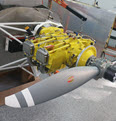
Joined: 14 Dec 2011
Posts: 166
Location: Newport News, VA
|
 Posted: Sun Oct 25, 2020 3:26 pm Post subject: Re: Positively Negative (-) ? Posted: Sun Oct 25, 2020 3:26 pm Post subject: Re: Positively Negative (-) ? |
 |
|
Don't forget to read the description paragraph for Z-15 in the Aeroelectric Connection book. Page Z-4 at http://www.aeroelectric.com/Books/Connection/AppZ_12A3.pdf
| | - The Matronics AeroElectric-List Email Forum - | | | Use the List Feature Navigator to browse the many List utilities available such as the Email Subscriptions page, Archive Search & Download, 7-Day Browse, Chat, FAQ, Photoshare, and much more:
http://www.matronics.com/Navigator?AeroElectric-List |
|
_________________
John Bright, RV-6A, at FWF, O-360
Z-101 single batt dual alt SDS EM-5-F.
john_s_bright@yahoo.com, Newport News, Va
N1921R links |
|
| Back to top |
|
 |
supik
Joined: 22 Aug 2018
Posts: 70
|
 Posted: Mon Oct 26, 2020 9:39 am Post subject: Re: Positively Negative (-) ? Posted: Mon Oct 26, 2020 9:39 am Post subject: Re: Positively Negative (-) ? |
 |
|
Thank you all!
I'll remove the long neg. wire and ground the battery locally.
| | - The Matronics AeroElectric-List Email Forum - | | | Use the List Feature Navigator to browse the many List utilities available such as the Email Subscriptions page, Archive Search & Download, 7-Day Browse, Chat, FAQ, Photoshare, and much more:
http://www.matronics.com/Navigator?AeroElectric-List |
|
_________________
Igor
RV10 in progress |
|
| Back to top |
|
 |
DougW
Joined: 16 Sep 2015
Posts: 14
Location: Washington
|
 Posted: Tue Oct 27, 2020 1:51 pm Post subject: Positively Negative (-) ? Posted: Tue Oct 27, 2020 1:51 pm Post subject: Positively Negative (-) ? |
 |
|
This comment may not be relevant as I am not aware of the engine installation. I have a single alternator dual battery configuration with batteries aft and 2 AWG cables between the batteries and firewall connection. From the latter connection, I feed the main bus and an e-bus via a diode. I also have direct switched feeds from the batteries to the e-bus. I have an electrically dependent automotive fuel injected conversion powerplant.
I found that when attempting to start on one battery, I could not get a reliable start. But when I switched to the second battery directly to the e-bus, no starting problem. My conclusion is that the voltage drop while cranking the engine was sufficient to cause the ignition system to not operate reliably. This may have been due to the 9-10v cranking voltage drop in in addition to the up to 1v drop across the diode. It is my understanding that most ignition systems need 10v to operate reliably.
My current process to start the engine is to crank on the A battery while feeding the B battery directly to the e-bus.
Again, don’t know if this is relevant to this discussion.
Regards, Doug Windhorn
From: owner-aeroelectric-list-server(at)matronics.com <owner-aeroelectric-list-server(at)matronics.com> On Behalf Of Robert L. Nuckolls, III
Sent: Sunday, October 25, 2020 11:32 AM
To: aeroelectric-list(at)matronics.com
Subject: Re: Positively Negative (-) ?
At 06:48 AM 10/25/2020, you wrote:
| Quote: |
--> AeroElectric-List message posted by: "supik" <bionicad(at)hotmail.com (bionicad(at)hotmail.com)>
After reading this article: https://www.kitplanes.com/positively-negative/
I ran a positive and a negative 2awg conductor from the back (battery) of my RV10 to the front. I missed the point where I had to calculate the total cable length for the intermittent starting process.. |
Igor, please don't do this . . .
There is no foundation in physics or practice that
justifies this.
Yes, the proposed 'upgrades' have some 'advantage'
but too small to observe and difficult to measure.
See Figure Z-15 for grounding architectures
that have successful track records going back
nearly a century.
| Quote: |
This leaves me with approx. 28ft total 2awg wire length installed.
-2awg (+) wire from battery to starter and 2awg (-) wire from the engine block to the firewall and from there to the battery. The only airframe negative is grounded at the firewall.
My question is: how much current does the B&C starter draw inrush and continuous to determine whether the 28ft 2awg wire can handle it without too much of voltage drop -thus hurting the starter's performance? |
"Too much voltage drop" is un-quantified.
Are you having problems cranking the engine?
"Hurting starter performance" is also
un-quantified. No starter EVER expects
to see 12v in any vehicle. It's a given
that internal resistance of the battery
added to cranking path resistance will
deliver 9-10 volts to the starter. Modern
starters not withstanding deliver much
better performance than the legacy
tractor starters fitted to most of
the Lycomings in the years before
B&C and they got the engine running
un spite of engine driven fuel pumps,
manual primer pumps, magnetos with
impulse couplers, etc. In fact, if
was skilled at getting the
variables corraled, the engine could
be started by hand.
The quantum jump in modern starter performance
pretty much eliminates starters as
a root cause for poor cranking. Adding
wires in the manner suggested in the article
is at best, a band-aid on some more
fundamental problem.
Bob . . .
| | - The Matronics AeroElectric-List Email Forum - | | | Use the List Feature Navigator to browse the many List utilities available such as the Email Subscriptions page, Archive Search & Download, 7-Day Browse, Chat, FAQ, Photoshare, and much more:
http://www.matronics.com/Navigator?AeroElectric-List |
|
|
|
| Back to top |
|
 |
nuckolls.bob(at)aeroelect
Guest
|
 Posted: Wed Oct 28, 2020 5:02 am Post subject: Positively Negative (-) ? Posted: Wed Oct 28, 2020 5:02 am Post subject: Positively Negative (-) ? |
 |
|
At 04:43 PM 10/27/2020, you wrote:
| Quote: | This comment may not be relevant as I am not aware of the engine installation. I have a single alternator dual battery configuration with batteries aft and 2 AWG cables between the batteries and firewall connection. From the latter connection, I feed the main bus and an e-bus via a diode. I also have direct switched feeds from the batteries to the e-bus. I have an electrically dependent automotive fuel injected conversion powerplant.
I found that when attempting to start on one battery, I could not get a reliable start. But when I switched to the second battery directly to the e-bus, no starting problem. My conclusion is that the voltage drop while cranking the engine was sufficient to cause the ignition system to not operate reliably. This may have been due to the 9-10v cranking voltage drop in in addition to the up to 1v drop across the diode. It is my understanding that most ignition systems need 10v to operate reliably.
My current process to start the engine is to crank on the A battery while feeding the B battery directly to the e-bus.
Again, donít know if this is relevant to this discussion.
|
Very much so . . . but to offer cognizant
analysis of your observation, we'd have to
see a schematic of your distribution system
and a good physical description of the
installation.
Your observations are no doubt accurate
but anecdotal with respect to cause and
effect.
You don't seem to have an issue with
cranking (starter) performance but instead,
the ignition system seems especially
sensitive to low supply voltage. This
is curious as automotive electronics are
designed to function under exceedingly
trying conditions.
The batteries in automobiles are the
second worst maintained in practice
(farm equipment comes first). Any
automotive designer worth his salt
strives for state of battery to be
the last bastion of determination
for getting ol' bessy fired up.
If the starter motor achieves
rotation at all, getting one ideally
charged cylinder past TDC is going
to speak to failure/success. Voltage
to the electrics is generally not
the limiting factor.
The article referenced at the start
of this thread speaks in generalities
and offers no data that quantifies
improvements to be secured nor does
offer anecdotal evidence of a problem
in practice having been resolved.
Your narrative at least describes
actions taken and improvements noted
as a consequence of that action. But
it too is short on data that would
help us understand exactly what
is happening.
Bob . . .
| | - The Matronics AeroElectric-List Email Forum - | | | Use the List Feature Navigator to browse the many List utilities available such as the Email Subscriptions page, Archive Search & Download, 7-Day Browse, Chat, FAQ, Photoshare, and much more:
http://www.matronics.com/Navigator?AeroElectric-List |
|
|
|
| Back to top |
|
 |
DougW
Joined: 16 Sep 2015
Posts: 14
Location: Washington
|
 Posted: Wed Oct 28, 2020 1:19 pm Post subject: Positively Negative (-) ? Posted: Wed Oct 28, 2020 1:19 pm Post subject: Positively Negative (-) ? |
 |
|
Bob,
Thank you for your comments. I have attached some JPEG images of my relevant schematics. The originals are .ODG drawings (can’t figure out how to transfer to PDF). I hope these may help; let me know if there is something else I can provide. FYI, the numbers interrupting the wires between devices (nodes) are connector pin numbers.
Not sure what you mean by “a good physical description of the installation.” The only thing I can add, not included in the drawings, is that the firewall passthroughs are 5/16” tin-plated threaded studs in an insulated frame mount commonly used by boaters. Batteries are Odyssey PC680’s.
The original electrical installation was done a couple decades ago and generally followed the drawings of the engine converter for those engine related components. I tried to follow your Z drawings (forgot which one) for overall ships electrical installation. I have not measured more than about .007 ohms resistance along any of the wires installed, but maybe I should recheck some of those.
Additional notations in your prior response.
Doug
From: owner-aeroelectric-list-server(at)matronics.com <owner-aeroelectric-list-server(at)matronics.com> On Behalf Of Robert L. Nuckolls, III
Sent: Wednesday, October 28, 2020 5:57 AM
To: aeroelectric-list(at)matronics.com
Subject: RE: Positively Negative (-) ?
At 04:43 PM 10/27/2020, you wrote:
| Quote: |
This comment may not be relevant as I am not aware of the engine installation. I have a single alternator dual battery configuration with batteries aft and 2 AWG cables between the batteries and firewall connection. From the latter connection, I feed the main bus and an e-bus via a diode. I also have direct switched feeds from the batteries to the e-bus. I have an electrically dependent automotive fuel injected conversion powerplant.
I found that when attempting to start on one battery, I could not get a reliable start. But when I switched to the second battery directly to the e-bus, no starting problem. My conclusion is that the voltage drop while cranking the engine was sufficient to cause the ignition system to not operate reliably. This may have been due to the 9-10v cranking voltage drop in in addition to the up to 1v drop across the diode. It is my understanding that most ignition systems need 10v to operate reliably.
My current process to start the engine is to crank on the A battery while feeding the B battery directly to the e-bus.
Again, don’t know if this is relevant to this discussion. |
Very much so . . . but to offer cognizant
analysis of your observation, we'd have to
see a schematic of your distribution system
and a good physical description of the
installation.
Your observations are no doubt accurate
but anecdotal with respect to cause and
effect.
You don't seem to have an issue with
cranking (starter) performance (true; should add that the original starter was replaced a few years ago) but instead,
the ignition system seems especially
sensitive to low supply voltage. This
is curious as automotive electronics are
designed to function under exceedingly
trying conditions. (The ignition module is an Electromotive Tec2 unit, doubtful that it was intended for automobiles, but….)
The batteries in automobiles are the
second worst maintained in practice
(farm equipment comes first). Any
automotive designer worth his salt
strives for state of battery to be
the last bastion of determination
for getting ol' bessy fired up.
If the starter motor achieves
rotation at all, getting one ideally
charged cylinder past TDC is going
to speak to failure/success. Voltage
to the electrics is generally not
the limiting factor. (I read somewhere that, in general, ignition modules typically recommended at least 10v to be reliable; don’t know if that is typical or referred to a specific brand module.)
The article referenced at the start
of this thread speaks in generalities
and offers no data that quantifies
improvements to be secured nor does
offer anecdotal evidence of a problem
in practice having been resolved.
Your narrative at least describes
actions taken and improvements noted
as a consequence of that action. But
it too is short on data that would
help us understand exactly what
is happening. (I’d like to know what’s happening, if only an intellectual exercise.)
Bob . . .
| | - The Matronics AeroElectric-List Email Forum - | | | Use the List Feature Navigator to browse the many List utilities available such as the Email Subscriptions page, Archive Search & Download, 7-Day Browse, Chat, FAQ, Photoshare, and much more:
http://www.matronics.com/Navigator?AeroElectric-List |
|
| Description: |
|
| Filesize: |
187.11 KB |
| Viewed: |
5802 Time(s) |
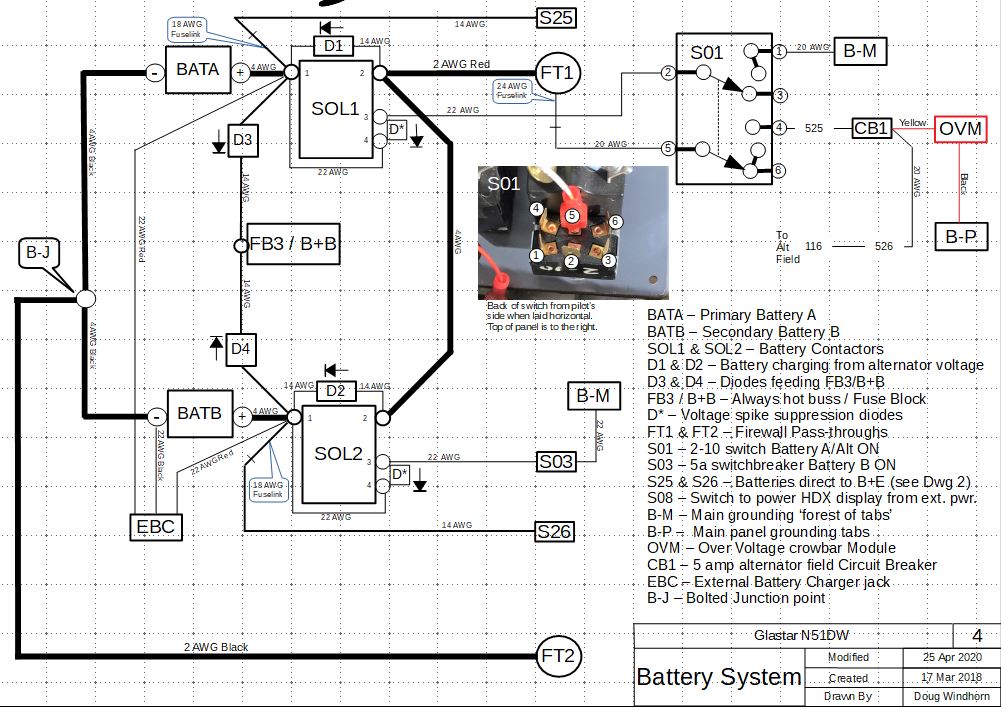
|
| Description: |
|
| Filesize: |
150.45 KB |
| Viewed: |
5802 Time(s) |
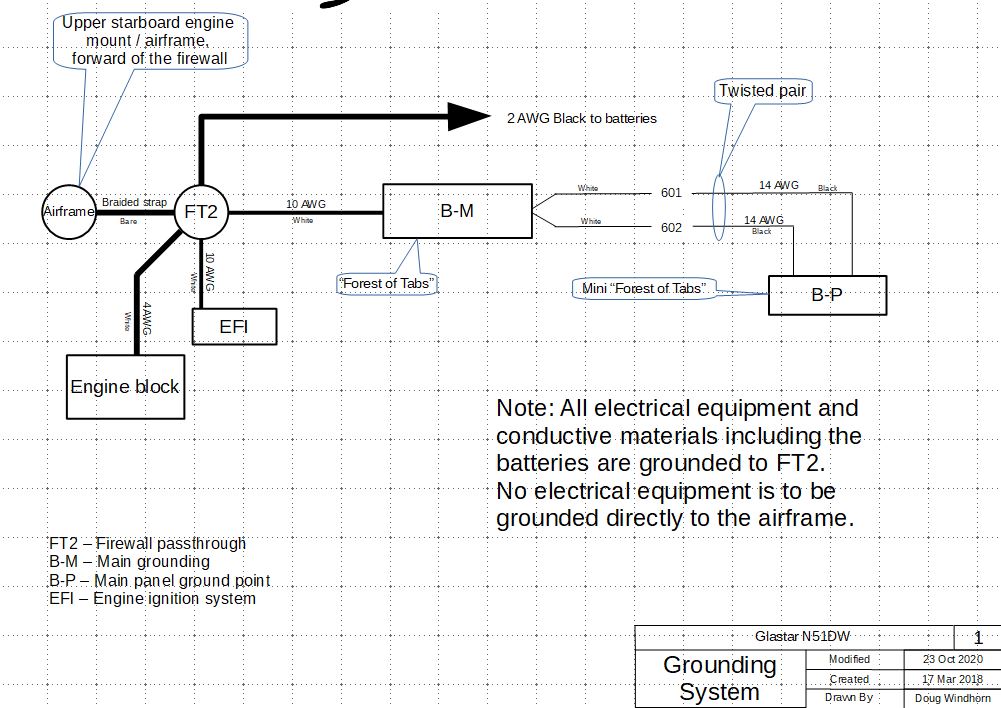
|
| Description: |
|
| Filesize: |
151.14 KB |
| Viewed: |
5802 Time(s) |
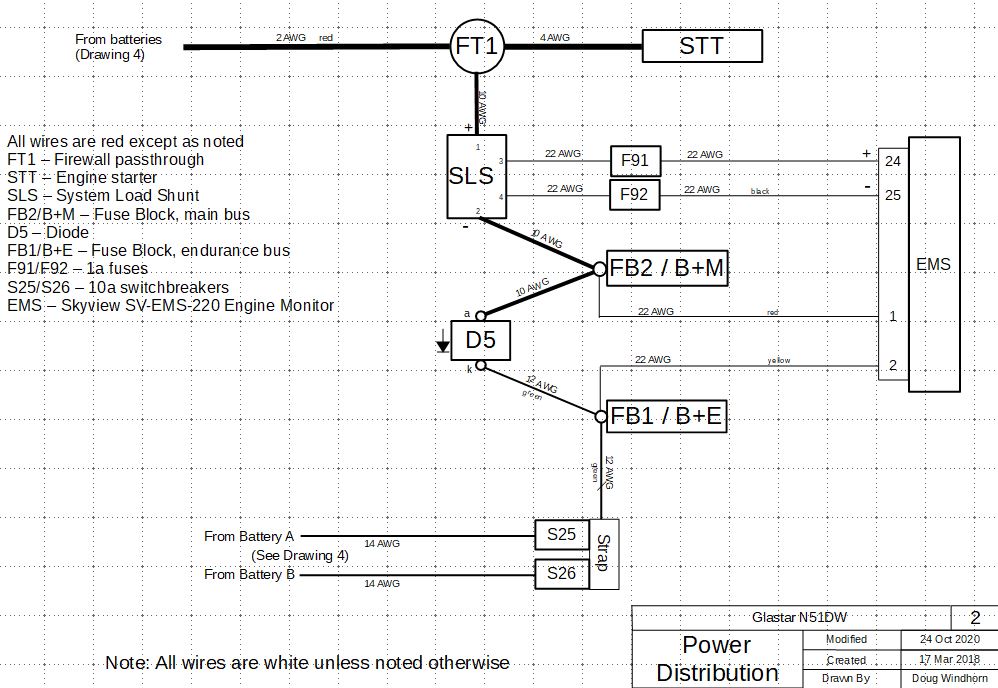
|
| Description: |
|
| Filesize: |
188.17 KB |
| Viewed: |
5802 Time(s) |
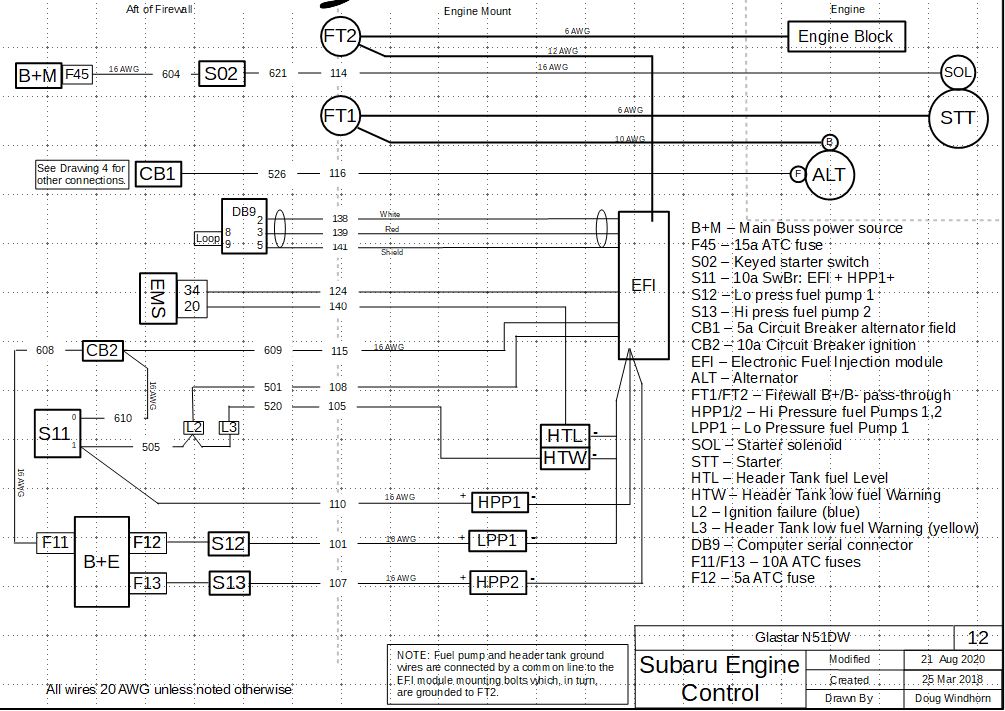
|
|
|
| Back to top |
|
 |
Ceengland
Joined: 11 Oct 2020
Posts: 391
Location: MS
|
 Posted: Wed Oct 28, 2020 5:03 pm Post subject: Positively Negative (-) ? Posted: Wed Oct 28, 2020 5:03 pm Post subject: Positively Negative (-) ? |
 |
|
Or, continue to use jpgs, so we can view them within the email instead
of having to download them & open separately in Adobe.

On 10/28/2020 7:24 PM, Dick Tasker wrote:
| Quote: |
<dick(at)thetaskerfamily.com>
If you can print ODG drawings you can use PDF Creator to make a PDF. 
Go to "https://www.pdfforge.org/pdfcreator/download" for the free
version.
I use it to make PDFs from any program that can print.
Dick Tasker
n1dw wrote:
>
> Bob,
>
> Thank you for your comments.  I have attached some JPEG images of my
> relevant schematics.  The originals are .ODG drawings (can’t figure
> out how to transfer to PDF).  I hope these may help; let me know if
> there is something else I can provide. FYI, the numbers interrupting
> the wires between devices (nodes) are connector pin numbers.
>
> Not sure what you mean by “a good physical description of the
> installation.‚Ä̬† The only thing I can add, not included in the
> drawings, is that the firewall passthroughs are 5/16‚ÄĚ tin-plated
> threaded studs in an insulated frame mount commonly used by boaters.
>  Batteries are Odyssey PC680’s.
>
> The original electrical installation was done a couple decades ago
> and generally followed the drawings of the engine converter for those
> engine related components. I tried to follow your Z drawings (forgot
> which one) for overall ships electrical installation.  I have not
> measured more than about .007 ohms resistance along any of the wires
> installed, but maybe I should recheck some of those.
>
> Additional notations in your prior response.
>
> Doug
>
> *From:* owner-aeroelectric-list-server(at)matronics.com
> <owner-aeroelectric-list-server(at)matronics.com> *On Behalf Of *Robert
> L. Nuckolls, III
> *Sent:* Wednesday, October 28, 2020 5:57 AM
> *To:* aeroelectric-list(at)matronics.com
> *Subject:* RE: Positively Negative (-) ?
>
> At 04:43 PM 10/27/2020, you wrote:
>     This comment may not be relevant as I am not aware of the engine
> installation.  I have a single alternator dual battery configuration
> with batteries aft and 2 AWG cables between the batteries
>     and firewall connection.  From the latter connection, I feed the
> main bus and an e-bus via a diode.  I also have direct switched feeds
> from the batteries to the e-bus.  I have an electrically
>     dependent automotive fuel injected conversion powerplant.
>
>     I found that when attempting to start on one battery, I could not
> get a reliable start.  But when I switched to the second battery
> directly to the e-bus, no starting problem.  My conclusion is
>     that the voltage drop while cranking the engine was sufficient to
> cause the ignition system to not operate reliably.  This may have
> been due to the 9-10v  cranking voltage drop in in addition to
>     the up to 1v drop across the diode.  It is my understanding that
> most ignition systems need 10v to operate reliably.
>
>     My current process to start the engine is to crank on the A
> battery while feeding the B battery directly to the e-bus.
>
>     Again, don’t know if this is relevant to this discussion.
>
>   Very much so . . . but to offer cognizant
>   analysis of your observation, we'd have to
>   see a schematic of your distribution system
>   and a good physical description of the
>   installation.
>
>   Your observations are no doubt accurate
>   but anecdotal with respect to cause and
>   effect.
>
>   You don't seem to have an issue with
>   cranking (starter) performance (true; should add that the original
> starter was replaced a few years ago) but instead,
>   the ignition system seems especially
>   sensitive to low supply voltage. This
>   is curious as automotive electronics are
>   designed to function under exceedingly
>   trying conditions. (The ignition module is an Electromotive Tec2
> unit, doubtful that it was intended for automobiles, but….)
>
>   The batteries in automobiles are the
>   second worst maintained in practice
>   (farm equipment comes first). Any
>   automotive designer worth his salt
>   strives for state of battery to be
>   the last bastion of determination
>   for getting ol' bessy fired up.
>
>   If the starter motor achieves
>   rotation at all, getting one ideally
>   charged cylinder past TDC is going
>   to speak to failure/success. Voltage
>   to the electrics is generally not
>   the limiting factor. (I read somewhere that, in general, ignition
> modules typically recommended at least 10v to be reliable; don’t know
> if that is typical or referred to a specific brand module.)
>
>   The article referenced at the start
>   of this thread speaks in generalities
>   and offers no data that quantifies
>   improvements to be secured nor does
>   offer anecdotal evidence of a problem
>   in practice having been resolved.
>
>   Your narrative at least describes
>   actions taken and improvements noted
>   as a consequence of that action. But
>   it too is short on data that would
>   help us understand exactly what
>   is happening. (I’d like to know what’s happening, if only an
> intellectual exercise.)
>
>   Bob . . .
>
|
--
This email has been checked for viruses by Avast antivirus software.
https://www.avast.com/antivirus
| | - The Matronics AeroElectric-List Email Forum - | | | Use the List Feature Navigator to browse the many List utilities available such as the Email Subscriptions page, Archive Search & Download, 7-Day Browse, Chat, FAQ, Photoshare, and much more:
http://www.matronics.com/Navigator?AeroElectric-List |
|
_________________
Charlie |
|
| Back to top |
|
 |
DougW
Joined: 16 Sep 2015
Posts: 14
Location: Washington
|
 Posted: Wed Oct 28, 2020 5:25 pm Post subject: Positively Negative (-) ? Posted: Wed Oct 28, 2020 5:25 pm Post subject: Positively Negative (-) ? |
 |
|
Dick, thanks for the tip. Have attached the newly created PDF versions.
Doug
--
| | - The Matronics AeroElectric-List Email Forum - | | | Use the List Feature Navigator to browse the many List utilities available such as the Email Subscriptions page, Archive Search & Download, 7-Day Browse, Chat, FAQ, Photoshare, and much more:
http://www.matronics.com/Navigator?AeroElectric-List |
|
| Description: |
|

Download |
| Filename: |
N51DW_1_Grounding_System.pdf |
| Filesize: |
47.91 KB |
| Downloaded: |
300 Time(s) |
| Description: |
|

Download |
| Filename: |
N51DW_2_Power_Distribution.pdf |
| Filesize: |
44.49 KB |
| Downloaded: |
257 Time(s) |
| Description: |
|

Download |
| Filename: |
N51DW_4_Battery_System.pdf |
| Filesize: |
139.56 KB |
| Downloaded: |
277 Time(s) |
| Description: |
|

Download |
| Filename: |
N51DW_12_Engine_Control.pdf |
| Filesize: |
630.6 KB |
| Downloaded: |
244 Time(s) |
|
|
| Back to top |
|
 |
DougW
Joined: 16 Sep 2015
Posts: 14
Location: Washington
|
 Posted: Wed Oct 28, 2020 5:26 pm Post subject: Positively Negative (-) ? Posted: Wed Oct 28, 2020 5:26 pm Post subject: Positively Negative (-) ? |
 |
|
Also a good thought Charlie. Now I am confused ūüėČ
Doug
--
| | - The Matronics AeroElectric-List Email Forum - | | | Use the List Feature Navigator to browse the many List utilities available such as the Email Subscriptions page, Archive Search & Download, 7-Day Browse, Chat, FAQ, Photoshare, and much more:
http://www.matronics.com/Navigator?AeroElectric-List |
|
|
|
| Back to top |
|
 |
|
|
You cannot post new topics in this forum
You cannot reply to topics in this forum
You cannot edit your posts in this forum
You cannot delete your posts in this forum
You cannot vote in polls in this forum
You cannot attach files in this forum
You can download files in this forum
|
Powered by phpBB © 2001, 2005 phpBB Group
|






